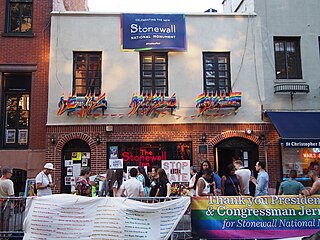These lists of television programs with LGBT characters include:

Lambda Literary Awards, also known as the "Lammys", are awarded yearly by Lambda Literary to recognize the crucial role LGBTQ+ writers play in shaping the world. The Lammys celebrate the very best in LGBTQ+ literature. The awards were instituted in 1989.

LGBTQ culture is a culture shared by lesbian, gay, bisexual, transgender, and queer individuals. It is sometimes referred to as queer culture, LGBT culture, and LGBTQIA culture, while the term gay culture may be used to mean either "LGBT culture" or homosexual culture specifically.
The large amount of lists of LGBTQ characters and media within the scope of "fiction and myth", which has been divided into the following:
The list of feature films with LGBT characters is split across the following pages:

LGBTQ themes in horror fiction refers to sexuality in horror fiction that can often focus on LGBTQ+ characters and themes within various forms of media. It may deal with characters who are coded as or who are openly LGBTQ+, or it may deal with themes or plots that are specific to gender and sexual minorities.
Outfest is an LGBTQ-oriented nonprofit that produces two film festivals, operates a movie streaming platform, and runs educational services for filmmakers in Los Angeles. Outfest is one of the key partners, alongside the Frameline Film Festival, the New York Lesbian, Gay, Bisexual, & Transgender Film Festival, and the Inside Out Film and Video Festival, in launching the North American Queer Festival Alliance, an initiative to further publicize and promote LGBT film.

LGBT representation in children's television is representation of LGBT topics, themes, and people in television programming meant for children. LGBT representation in children's programming was often uncommon to non-existent for much of television's history up to the 2010s, but has significantly increased since then.
Historically, the portrayal of lesbian, gay, bisexual, transgender and queer (LGBTQ) people in media has been largely negative if not altogether absent, reflecting a general cultural intolerance of LGBTQ individuals; however, from the 1990s to present day, there has been an increase in the positive depictions of LGBTQ people, issues, and concerns within mainstream media in North America. The LGBTQ communities have taken an increasingly proactive stand in defining their own culture, with a primary goal of achieving an affirmative visibility in mainstream media. The positive portrayal or increased presence of the LGBTQ communities in media has served to increase acceptance and support for LGBT communities, establish LGBTQ communities as a norm, and provide information on the topic.
LGBTQ+ media or gay media refers to media whose primary target audience is members of the LGBTQ community. Secondary targets are LGBTQ+ allies, and in some instances those who oppose gay rights may be targeted as a form of activism. Gay or queer media can also be defined as web sites, films, magazines and other cultural products that were created by queer individuals, or groups that are typically out, meaning that they are public or open about their identity. LGBTQ creators do not always include LGBTQ themes or issues in the media that they produce, but there are often at least subtle references to queerness in these media.
Since the transition into the modern-day gay rights movement, homosexuality has appeared more frequently in American film and cinema.

The following outline offers an overview and guide to LGBTQ topics:

LGBT culture in Baltimore, Maryland is an important part of the culture of Baltimore, as well as being a focal point for the wider LGBT community in the Baltimore metropolitan area. Mount Vernon, known as Baltimore's gay village, is the central hub of the city's lesbian, gay, bisexual, and transgender communities.

Gay is a term that primarily refers to a homosexual person or the trait of being homosexual. The term's use as a reference to male homosexuality may date as early as the late 19th century, but its use gradually increased in the mid-20th century. In modern English, gay has come to be used as an adjective, and as a noun, referring to the community, practices and cultures associated with homosexuality. In the 1960s, gay became the word favored by homosexual men to describe their sexual orientation. By the end of the 20th century, the word gay was recommended by major LGBT groups and style guides to describe people attracted to members of the same sex, although it is more commonly used to refer specifically to men. At about the same time, a new, pejorative use became prevalent in some parts of the world. Among younger speakers, the word has a meaning ranging from derision to a light-hearted mockery or ridicule. The extent to which these usages still retain connotations of homosexuality has been debated and harshly criticized. This page examines gay characters in fictional works as a whole, focusing on characters and tropes in cinema and fantasy.
This article features the history of the representation of lesbian, gay, bisexual, transgender and queer (LGBTQ) characters in animated productions under The Walt Disney Company, including films from the studios Walt Disney Animation Studios and Pixar, and programming from the Disney Branded Television channels as well as the streaming service Disney+. From 1983 onward, Disney struggled with LGBTQ representation in their animated series, and their content often included LGBTQ stereotypes or the content was censored in series such as Blazing Dragons. Some creators have also criticized Disney studio executives of cutting LGBTQ scenes from their shows in the past, or criticized that their shows were not seen as part of the "Disney brand", like The Owl House.







